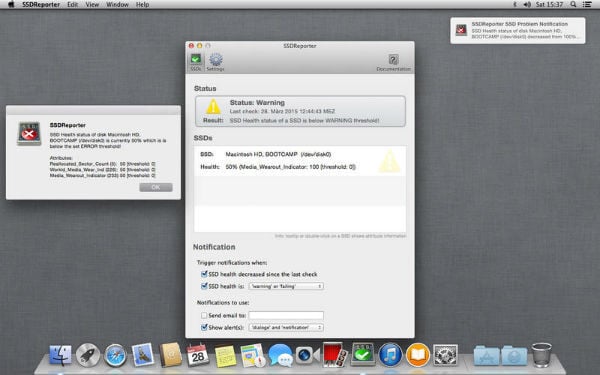Tri-ger Mac OS
IMac 27 i7, Mac OS X (10.7.2), 64G iPhone 4/S, 32G iPad 3G+WiFi Posted on Oct 24, 2011 7:11 PM Reply I have this question too (1014) I have this question too Me too (1014) Me too.
- How to Create a Trigger To create a trigger, open the Preferencespanel. Select the Profilestab. Choose the profile to which you wish to add a trigger. Then select the Advancedtab. Click the Editbutton in the Triggerssection.
- As many of you will be aware, Mac OS X has a rich set of UNIX tools under the hood that can be leveraged to make the end users life a little easier. Although scripting is an art form in itself, when you start writing scripts for OS X, working out how to get the script triggered at the right time and by the right user account can be a challenge.
Tri-ger Mac Os Catalina
For system administrators, macOS roaming helps your Mac stay connected as it moves between different places within your office network.
Trigger threshold
The trigger threshold is the minimum signal level a client requires to maintain the current connection.
macOS clients monitor and maintain the current BSSID’s connection until the RSSI crosses the -75 dBm threshold. After RSSI crosses that threshold, macOS scans for roam candidate BSSIDs for the current ESSID.
Consider this threshold in view of the signal overlap between your wireless cells. macOS maintains a connection until the -75 dBm threshold, but 5 GHz cells are designed with a -67 dBm overlap. Those clients will remain connected to the current BSSID longer than you might expect.
Also consider how the cell overlap is measured. The antennas on computers vary from model to model, and they see different cell boundaries than may be expected. It's always best to use the target device when you measure cell overlap.
Selection criteria for band, network, and roam candidates
macOS always defaults to the 5 GHz band over the 2.4 GHz band. This happens as long as the RSSI for a 5 GHz network is -68 dBm or better.
If multiple 5 GHz SSIDs meet this level, macOS chooses a network based on these criteria:

- 802.11ax is preferred over 802.11ac.
- 802.11ac is preferred over 802.11n or 802.11a.
- 802.11n is preferred over 802.11a.
- 80 MHz channel width is preferred over 40 MHz or 20 MHz.
- 40 MHz channel width is preferred over 20 MHz.
macOS doesn't support 802.11k. macOS does interoperate with SSIDs that have 802.11k enabled.
macOS selects a target BSSID whose reported RSSI is 12 dB or greater than the current BSSID’s RSSI. This is true even if the macOS client is idle or transmitting/receiving data.
Roam performance
Roam performance describes how long a client needs to authenticate successfully to a new BSSID.
Finding a valid network and AP is only part of the process. The client must complete the roam process quickly and without interruption so the user doesn't experience downtime. Roaming involves the client authenticating against the new BSSID and deauthenticating from the current BSSID. The security and authentication method determines how quickly this can happen.
First, 802.1X-based authentication requires the client to complete the entire EAP key exchange. Then, it can deauthenticate from the current BSSID. Depending on the environment’s authentication infrastructure, this might take several seconds. End users could experience interrupted service in the form of dead air.
macOS supports static PMKID (Pairwise Master Key identifier) caching to help optimize roaming between BSSIDs in the same ESSID. macOS doesn't support Fast BSS Transition, also known as 802.11r. You don't have to deploy additional SSIDs to support macOS because macOS interoperates with 802.11r.
Measure Client RSSI

macOS offers a few built-in tools that scan to measure RSSI.
To learn the RSSI for the associated network, hold the Option key while you click the Wi-Fi menu .
To learn the RSSI for networks in the client’s environment, use Wireless Diagnostics. To open Wireless Diagnostics, Option-click on the Wi-Fi menu , then select Open Wireless Diagnostic. In the menu bar, choose Window > Scan to find all nearby wireless networks and measure their RSSI.
Tri-ger Mac Os Download
XLN Audio – Addictive Trigger Complete for MacOS X Download
XLN Audio – Addictive Trigger Complete free download the latest via direct link. We know that XLN Audio – Addictive Trigger Complete vst crack works on your MAC, It is 100% working.
Features of XLN Audio – Addictive Trigger Complete:
- An impressive plugin that’s used for replacing the drum sounds and it utilizes the new technology to operate easily.
- Considered as the most precise and smart plugin as it includes new technologies called Audio Fingerprint.
- There is a new system that uses FFT analysis to precisely identify the drums sound.
- The accurate detection and some notable noises are there on one plugin.
- Each of the new technologies are combined with the finest of the sounds in addition to capabilities from the Additive Drums 2.
- Represents the fastest as well because most true fun way to take your live drums and sound them to a whole new level.
Tri-ger Mac Os Update
System Requirements:
- Memory (RAM): 2 GB of RAM required.
- Hard Disk Space: 1.4 GB of free space required.
- Processor: Intel Dual Core processor or later.
- Operating System: Mac OS X 10.6 or later.
- Machine: Apple Macbook
Related Posts:
Gracias por el aporte.